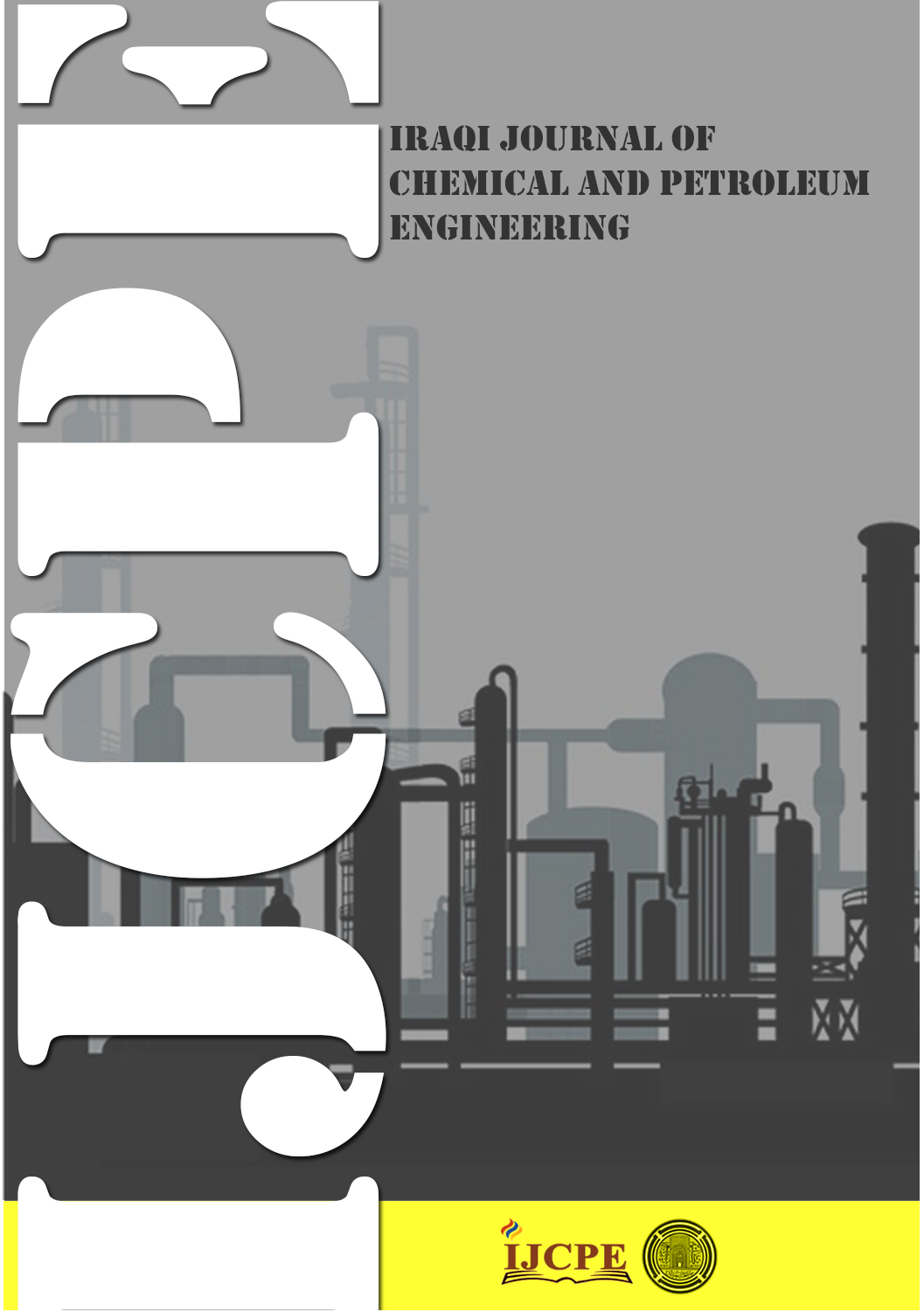The utilization of nanoparticles to modify surface properties in acidification processes
DOI:
https://doi.org/10.31699/IJCPE.2025.2.6Keywords:
Acidic Nanofluids; Surface Properties; Zeta Potential Stability; Contact Angle of Nanofluids; SnO2 nanoparticles; TiO2 nanoparticlesAbstract
Stimulation plays a crucial role in the oil and gas industry, particularly in the acidizing process. Thus, the development of acidification processes is essential for improving the productivity index and enhancing the physical properties of reservoirs. This research investigates the effect of Tin oxide (SnO2) and Titanium dioxide (TiO2) nanomaterials on the surface properties in acidic media of hydrochloric acid (HCl) at various acid and nanomaterials concentrations, as well as their impact on the wettability of carbonate rocks. To achieve this, surface tension, contact angle, and zeta-potential were measured using various instruments. The findings show that SnO2 and TiO2, at a concentration of 1000 ppm, significantly reduce surface tension to 34.69 and 43.44 mN/m, respectively, while maintaining stability with zeta potential values up to 51.27 and 49.17 mV, respectively. These results exceed the generally accepted stability threshold of around ±30 mV, indicating a strong electrostatic repulsion that prevents agglomeration and ensures prolonged suspension stability. Additionally, the findings show a substantial decrease in contact angles, from 95.17° to 16.32° with SnO2 and from 98.48° to 25.26° with TiO2. This shift indicates a transition from non-wetting to a more wetting condition, which is crucial because it reflects an increased affinity of the acid solution for the carbonate rock surfaces. This results in promoting better acid distribution and enhancing rock dissolution. In conclusion, both SnO2 and TiO2 reveal excellent performance as surfactants in the stimulation process, presenting substantial benefits for the acidizing process in the oil and gas industry.
Received on 13/09/2024
Received in Revised Form on 19/03/2025
Accepted on 19/03/2025
Published on 30/06/2025
References
[1] F. H. Al-Mahdawi and K. Saad, "Enhancement of drilling fluid properties using nanoparticles," Iraqi Journal of Chemical and Petroleum Engineering, vol. 19, no. 2, pp. 21-26, 2018. https://doi.org/10.31699/IJCPE.2018.2.4
[2] S. Y. Alssafar and F. H. Al-Mahdawi, "New study of MgO NPs in drilling fluid to reduce stick-slip vibration in drilling system," Iraqi Journal of Chemical and Petroleum Engineering, vol. 20, no. 2, pp. 51-59, 2019. https://doi.org/10.31699/IJCPE.2019.2.7
[3] M. A. Sheremet, "Applications of nanofluids," Nanomaterials, vol. 11, no. 7, p. 1716, 2021. https://doi.org/10.3390/nano11071716
[4] U. Alameedy, A. Fatah, A. K. Abbas, and A. Al-Yaseri, "Matrix acidizing in carbonate rocks and the impact on geomechanical properties: A review," Fuel, vol. 349, p. 128586, 2023. https://doi.org/10.1016/j.fuel.2023.128586
[5] R. P. Gajipara, A. D. Hill, D. Zhu, N. AlNajjar, N. Chkolny, and M. Weissenberger, "Systematic evaluation of alternative acid system for high-temperature carbonate formation," in Society of Petroleum Engineers Western Regional Meeting, p. D031S012R005, SPE, 2023. https://doi.org/10.2118/213006-MS
[6] M. A. Muhsan and A. F. Zahoor, "Reclamation of mineral acids from various waste streams using solvent extraction technique: a review," Geosystem Engineering, vol. 26, no. 5, pp. 218-238, 2023. https://doi.org/10.1080/12269328.2023.2202206
[7] A. Sadiq, M. Y. Fattah, and M. F. Aswad, "Enhancement of the acid resistance of silty clay using nano- magnesium oxide," Materials, vol. 16, no. 14, p. 5035, 2023. https://doi.org/10.3390/ma16145035
[8] H. Machrafi, "Surface tension of nanoparticle dispersions unravelled by size-dependent non-occupied sites free energy versus adsorption kinetics," Nature Partner Journals Microgravity, vol. 8, no. 1, p. 47, 2022. https://doi.org/10.1038/s41526-022-00234-3
[9] M. Haroun, M. M. Rahman, M. Al Kobaisi, M. Kim, A. Suboyin, B. Somra, and S. Punjabi, "Investigation of hybrid nanoparticle–acid fluids (HNAFs): Influence of wettability and interfacial tension mechanisms in harsh carbonate reservoirs for improved oil recovery," American Chemical Society Omega, vol. 7, no. 45, pp. 40853-40859, 2022. https://doi.org/10.1021/acsomega.2c03626
[10] D. R. Grisham and V. Nanda, "Zeta potential prediction from protein structure in general aqueous electrolyte solutions," Langmuir, vol. 36, no. 46, pp. 13799-13803, 2020. https://doi.org/10.1021/acs.langmuir.0c02031
[11] M. Iqbal, A. Sergis, and Y. Hardalupas, "Stability of Nanofluids," in Fundamentals and Transport Properties of Nanofluids, S. M. S. Murshed, Ed., The Royal Society of Chemistry, 2022, ch. 2, pp. 41-70. https://doi.org/10.1039/9781839166457-00041
[12] S. K. Singh, “Review on the stability of the nanofluids.” in Pipeline Engineering - Design, Failure, and Management, IntechOpen, 2023. https://doi.org/10.5772/intechopen.107154
[13] N. Arora and M. Gupta, "Stability evaluation and enhancement methods in nanofluids: A review," in American Institute of Physics Conference Proceedings, vol. 2341, no. 1, 2021 https://doi.org/10.1063/5.0050106
[14] F. H. Al-Ogaili, F. H. Almahdawi, and J. A. Ali, "Evaluating filtration and thermal stability of water-based mud using green synthesized zinc oxide nanoparticles," Iraqi Journal of Chemical and Petroleum Engineering, vol. 24, no. 4, pp. 91-98, 2023. https://doi.org/10.31699/IJCPE.2023.4.9
[15] K. Abe, K. Negishi, and H. Fujii, "Experimental investigation of the effects of the sizes and concentrations of SiO2 nanoparticles on wettability alteration and oil recovery," Energy and Fuels, vol. 37, no. 10, pp. 7122-7129, 2023. https://doi.org/10.1021/acs.energyfuels.3c00415
[16] K. Hassani, W. Zheng, and B. Rostami, "Rock wettability and interfacial tension improvement by exposure time effect in modified water injection process coupled with silica nanoparticles," Petroleum Science and Technology, vol. 42, no. 9, pp. 1031-1046, 2024. https://doi.org/10.1080/10916466.2023.2223641
[17] G. Kumar, U. S. Behera, E. Mani, and J. S. Sangwai, "Engineering the wettability alteration of sandstone using surfactant-assisted functional silica nanofluids in low-salinity seawater for enhanced oil recovery," American Chemical Society Engineering, vol. 2, no. 5, pp. 421-435, 2022. https://doi.org/10.1021/acsengineeringau.2c00007
[18] H. Pashaei, A. Ghaemi, and R. Miri, "The effect of nano heavy metal oxide particles on the wettability of carbonate reservoir rock," Society of Petroleum Engineers Reservoir Evaluation and Engineering, vol. 26, no. 04, pp. 1364-1377, 2023. https://doi.org/10.2118/214694-PA
[19] M. S. Hosseini, M. Khazaei, M. Misaghi, and M. H. Koosheshi, "Improving the stability of nanofluids via surface-modified titanium dioxide nanoparticles for wettability alteration of oil-wet carbonate reservoirs," Materials Research Express, vol. 9, no. 3, p. 035005, 2022. https://doi.org/10.1088/2053-1591/ac4fdf
[20] A. Goharzadeh, Y. Y. Fatt, and J. S. Sangwai, "Effect of TiO2-SiO2 hybrid nanofluids on enhanced oil recovery process under different wettability conditions," Capillarity, vol. 8, no. 1, 2023. https://doi.org/10.46690/capi.2023.07.01
[21] J. Zhang, L. Li, and H. Li, "Adsorption-controlled wettability and self-cleaning of TiO2," Langmuir, vol. 39, no. 17, pp. 6188-6200, 2023. https://doi.org/10.1021/acs.langmuir.3c00324
[22] S. R. Mishra and M. Ahmaruzzaman, "Tin oxide based nanostructured materials: synthesis and potential applications," Nanoscale, vol. 14, no. 5, pp. 1566-1605, 2022. https://doi.org/10.1039/D1NR07040A
[23] F. H. Almahdawi, U. Alameedy, A. Almomen, A. A. Al-Haleem, A. Saadi, and Y. M. Mukhtar, "The impact of acid fracking injection pressure on the carbonate-Mishrif reservoir: a field investigation," in International Petroleum and Petrochemical Technology Conference, pp. 622-641, Singapore: Springer Nature Singapore, 2022. https://doi.org/10.1007/978-981-99-2649-7_54
Downloads
Published
Issue
Section
License
Copyright (c) 2025 The Author(s). Published by College of Engineering, University of Baghdad.

This work is licensed under a Creative Commons Attribution 4.0 International License.













